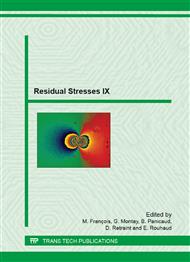p.155
p.162
p.169
p.175
p.181
p.187
p.192
p.197
p.203
Material Removal, Correction and Laboratory X-Ray Diffraction
Abstract:
Laboratory X-ray diffraction is commonly used for surface residual stresses determination. Nevertheless, the in-depth residual stress gradient also needs to be known. Chemical or electro-polishing method is generally used for material removal. However, material removal may seek a new equilibrium and stress field may change in such a way that experimental residual stress values must be corrected. Different methods exist to account for the residual stress relaxation associated with the material removal operation and will be discussed in this paper.
Info:
Periodical:
Pages:
181-186
Citation:
Online since:
August 2014
Authors:
Keywords:
Permissions:
Share:
Citation:


